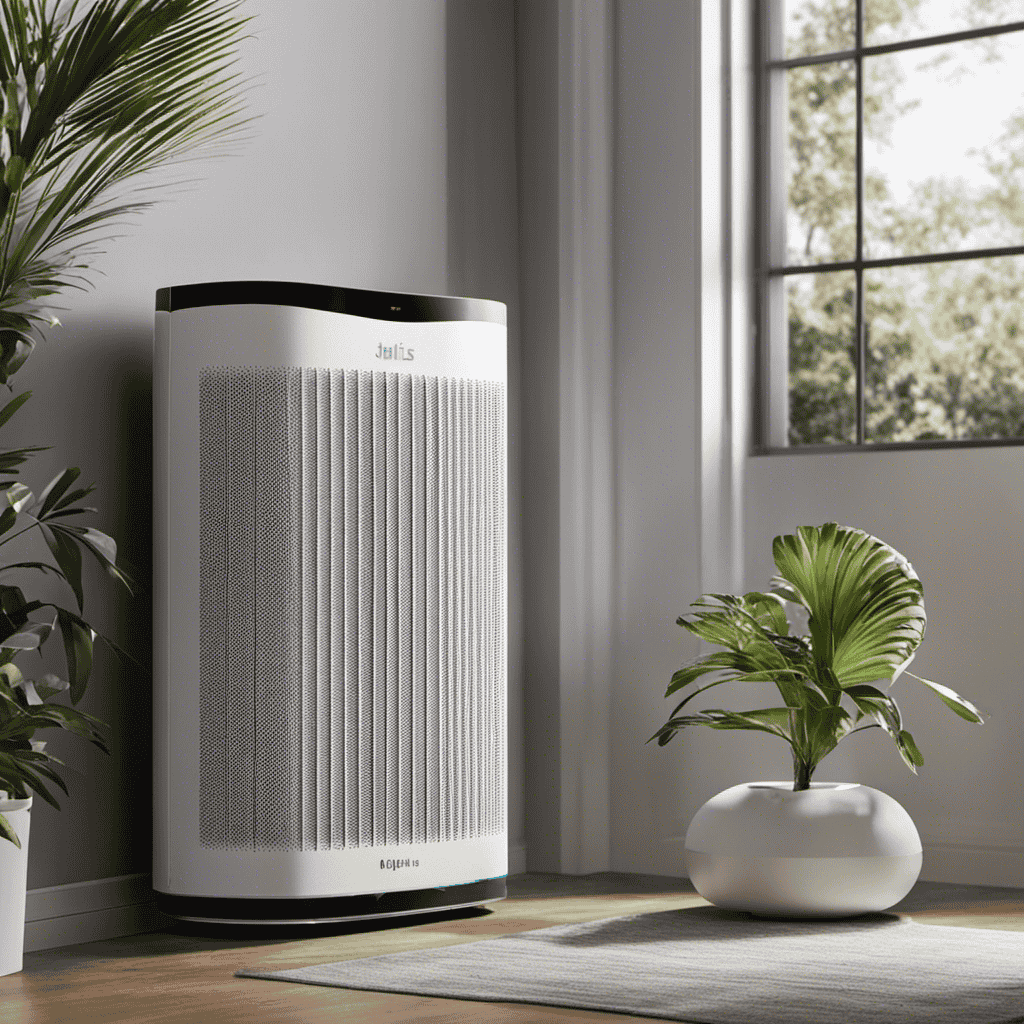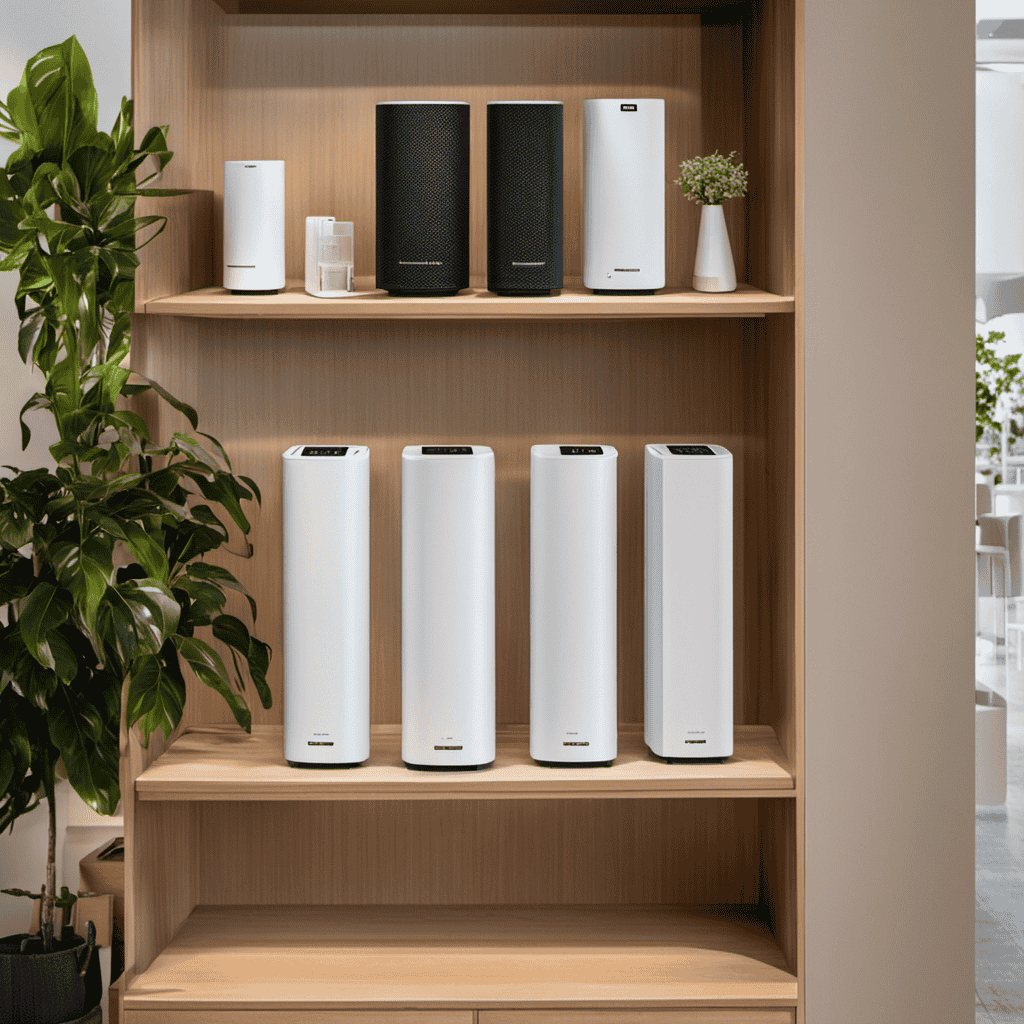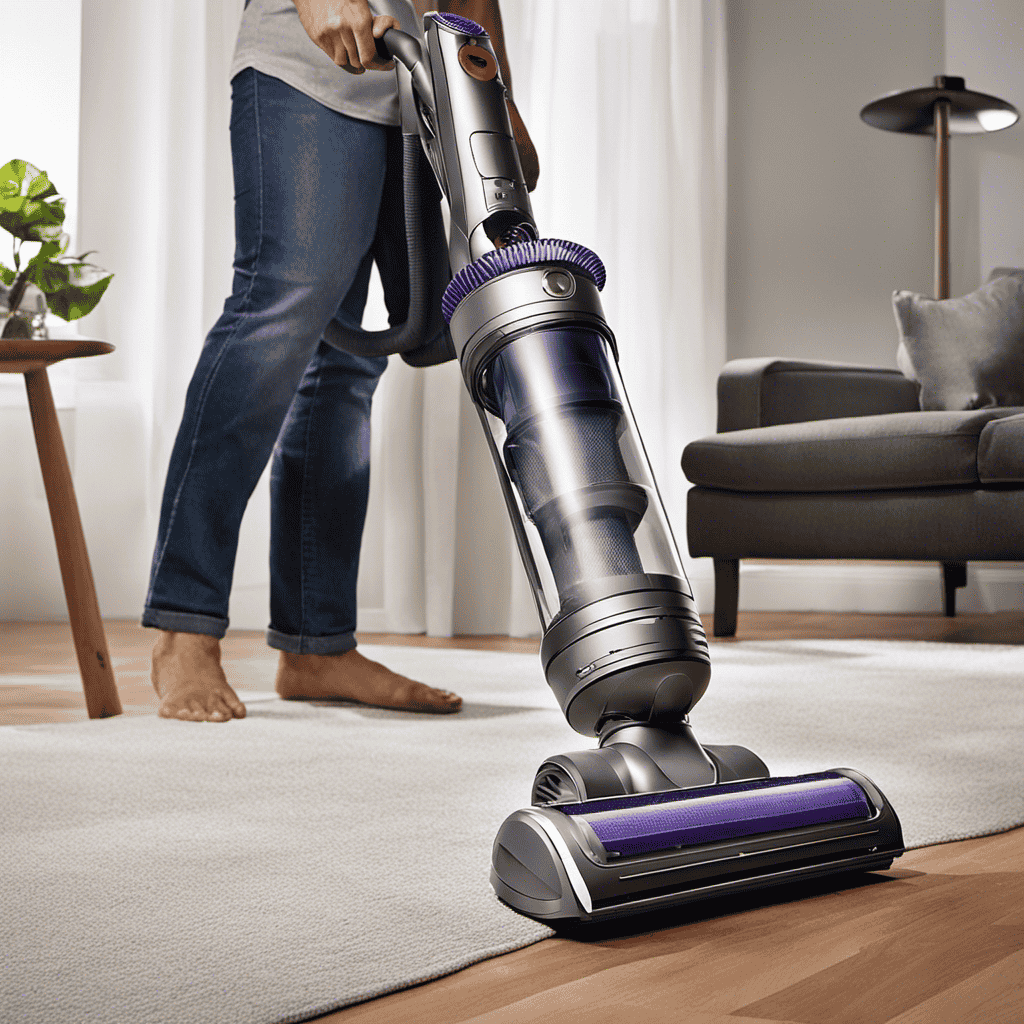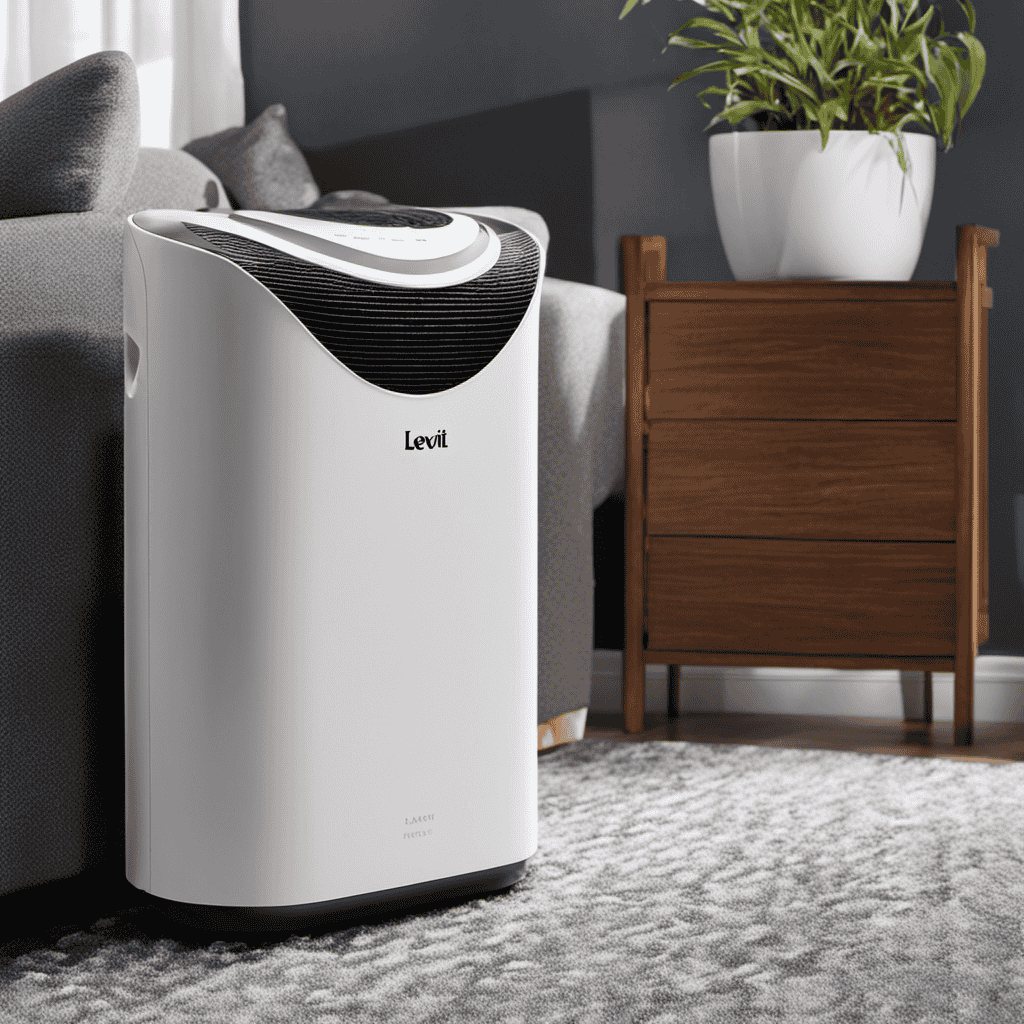I need to set the record straight regarding this topic – when do you actually need an air purifier?
Well, let me tell you, it’s not just about freshening up your space. Using an air purifier can actually have some serious health benefits.
But how do you know when it’s time to invest in one? In this article, we’ll dive into the common indoor air pollutants, the signs that indicate you need an air purifier, and the different types available.
So, let’s get to the bottom of this clean air conundrum!
Key Takeaways
- Poor indoor air quality can lead to respiratory issues, allergies, and asthma.
- Air purifiers effectively filter out allergens, pollutants, and odors from the air.
- Using air purifiers reduces allergy symptoms, improves respiratory function, and lowers the risk of developing respiratory conditions.
- Air purifiers are effective in removing airborne allergens and eliminating unpleasant odors.
Health Benefits of Using an Air Purifier
Using an air purifier can greatly improve your health by removing allergens and pollutants from the air you breathe. Air purifiers have numerous benefits when it comes to improving air quality. They can effectively remove dust, pollen, pet dander, mold spores, and other airborne particles that can trigger allergies and respiratory problems. By filtering out these irritants, air purifiers help create a cleaner and healthier indoor environment.
Additionally, air purifiers can also eliminate harmful gases and odors, such as smoke and volatile organic compounds (VOCs), which are commonly found in household products and contribute to poor indoor air quality. With regular use of an air purifier, you can experience fewer allergy symptoms, improved respiratory function, and a reduced risk of developing respiratory conditions.
Now, let’s explore some common indoor air pollutants.
Common Indoor Air Pollutants
When it comes to understanding the impact of indoor air pollutants on our health, it’s important to first identify the sources of these harmful contaminants.
Whether it’s from tobacco smoke, household cleaning products, or mold growth, these pollutants can have detrimental effects on our respiratory system, cardiovascular health, and overall well-being.
Harmful Pollutant Sources
One of the main sources of harmful pollutants in the air is vehicle emissions. When it comes to indoor air quality, it’s important to understand the different sources of air pollution.
In addition to vehicle emissions, other common sources include tobacco smoke, household cleaning products, and building materials. These pollutants can have a significant impact on our health, leading to respiratory issues, allergies, and even more serious conditions like asthma and lung cancer.
Research has shown that indoor air can be two to five times more polluted than outdoor air, making it crucial to take steps to improve air quality in our homes and workplaces. This can be achieved through proper ventilation, regular cleaning, and the use of air purifiers to filter out harmful pollutants.
Health Effects of Pollutants?
The health effects of harmful pollutants can range from respiratory issues to more serious conditions like asthma and lung cancer. It is crucial to address the impact of pollution on our respiratory health and take steps towards pollution prevention.
Research shows that long-term exposure to pollutants can lead to chronic respiratory diseases such as bronchitis and emphysema. These pollutants, including fine particulate matter and volatile organic compounds, can cause inflammation in the airways and decrease lung function. Additionally, studies have linked air pollution exposure to an increased risk of respiratory infections and exacerbation of existing respiratory conditions.
To mitigate these health risks, it is important to implement measures that reduce pollution levels, such as promoting cleaner energy sources, implementing stricter emission standards, and utilizing air purifiers to improve indoor air quality. By prioritizing pollution prevention, we can safeguard our respiratory health and reduce the burden of respiratory diseases on individuals and communities.
Signs You Need an Air Purifier
As someone who has struggled with allergies for years, I understand the frustration that comes with worsening allergy symptoms.
It’s important to recognize the potential causes of these worsening symptoms, and one possible culprit could be poor indoor air quality.
Lingering unpleasant odors can be a sign of pollutants in the air that can trigger or exacerbate allergic reactions, making it essential to address this issue for improved respiratory health.
Allergy Symptoms Worsening
If you’re experiencing worsening allergy symptoms, it’s time to consider using an air purifier. Pollen allergies and seasonal allergies can be a nightmare for those affected. Here’s why an air purifier can make a significant difference:
-
Removes airborne allergens: An air purifier traps pollen particles, dust mites, and other allergens, preventing them from circulating in your home.
-
Filters out pollutants: It captures and filters out common pollutants like pet dander, mold spores, and smoke particles, providing relief from allergy symptoms.
-
Improves indoor air quality: With an air purifier, you can enjoy cleaner, fresher air indoors, reducing the chances of allergy-triggering particles entering your respiratory system.
-
Reduces reliance on medication: By eliminating allergens from the air, an air purifier can potentially reduce the need for medication to manage allergy symptoms.
Considering the benefits an air purifier can provide, it’s a worthwhile investment for anyone suffering from worsening allergy symptoms.
Now, let’s explore how an air purifier can also tackle lingering unpleasant odors.
Lingering Unpleasant Odors?
Now, let’s see how an air purifier can help with those lingering unpleasant odors.
Lingering odors can be quite bothersome and can affect the overall comfort of your living space. Luckily, air purifiers are designed to eliminate smells and improve indoor air quality.
These devices work by using filters to capture and trap odorous particles, such as pet dander, smoke, and cooking smells. The filters in air purifiers are specifically designed to target and remove these odor-causing particles, effectively reducing the unpleasant smells that linger in your home.
Additionally, some air purifiers also come with activated carbon filters, which are highly effective in absorbing and neutralizing odors.
How Air Purifiers Work
Air purifiers work by trapping and filtering harmful particles from the air. They are designed to improve indoor air quality and provide several benefits.
-
Removes allergens: Air purifiers are effective in capturing allergens such as pollen, dust mites, and pet dander, reducing allergy symptoms and improving respiratory health.
-
Eliminates odors: By neutralizing odors caused by cooking, pets, or smoke, air purifiers help create a fresh and pleasant environment.
-
Reduces airborne germs: Certain air purifiers use technologies like UV light or ionization to kill bacteria, viruses, and other harmful microorganisms, enhancing overall hygiene.
-
Filters out pollutants: Air purifiers can remove pollutants such as volatile organic compounds (VOCs), chemicals, and smoke particles, safeguarding against potential health risks.
Understanding how air purifiers work and their benefits is crucial when considering the type of air purifier that best suits your needs.
Now, let’s delve into the different types of air purifiers available in the market.
Types of Air Purifiers
There are various types of air purifiers available in the market to cater to different needs and preferences.
When it comes to air purifier brands, some popular options include Dyson, Honeywell, Blueair, and Coway. Each brand offers different features and technologies to improve indoor air quality.
The cost of air purifiers can vary depending on the brand, size, and additional features. Generally, air purifiers range from around $100 to $1000. Higher-end models often come with advanced filtration systems and smart features.
It is important to consider factors such as room size, filtration efficiency, noise level, and maintenance costs when choosing an air purifier. Additionally, it is recommended to read customer reviews and compare different brands to make an informed decision.
Choosing the Right Air Purifier for Your Home
When choosing the right air purifier for your home, it’s important to consider factors such as room size and filtration efficiency. To make an informed decision, I conducted thorough research on air purifiers and found the following key points to consider:
-
Room size: Determine the square footage of the room you want to purify. This will help you determine the appropriate purifier size and capacity needed for efficient air cleaning.
-
Filtration efficiency: Look for air purifiers with HEPA filters, as they are highly effective in capturing airborne particles, allergens, and pollutants.
-
Air purifier maintenance: Consider the maintenance requirements of the purifier, such as filter replacements and cleaning. Some models require more frequent maintenance than others, so factor in the time and cost involved.
-
Cost of air purifiers: Set a budget and compare the prices of different models. Keep in mind that cheaper air purifiers may not have the same filtration efficiency or durability as higher-end options.
Frequently Asked Questions
Can Air Purifiers Completely Eliminate All Indoor Air Pollutants?
Yes, air purifiers can effectively eliminate many indoor air pollutants. However, it’s important to note that they may not completely eliminate all pollutants. Despite this, air purifiers offer numerous benefits and are cost-effective in improving indoor air quality.
How Often Should I Replace the Filters in My Air Purifier?
I replace my air purifier filters religiously, as neglecting them leads to a disaster. Signs that filters need replacing include reduced airflow and a noticeable decline in air quality. Clean your air purifier regularly to ensure optimal performance.
Are Air Purifiers Effective in Reducing Allergens Like Pollen and Pet Dander?
Yes, air purifiers are effective in reducing allergens like pollen and pet dander. Regular air purifier maintenance ensures optimal performance. Additionally, using air purifiers in offices provides numerous benefits, such as improved air quality and decreased respiratory issues.
Can Air Purifiers Remove Unpleasant Odors From the Air?
Yes, air purifiers can effectively remove unpleasant odors from the air. They use advanced technology to filter out odor-causing particles, improving the overall air quality and creating a more pleasant environment.
Are There Any Side Effects or Health Risks Associated With Using an Air Purifier for Long Periods of Time?
Using an air purifier for long periods of time can have potential side effects and health risks. It’s important to be aware of the potential risks and consult with a professional before using one extensively.
Conclusion
In conclusion, after conducting thorough research, I firmly believe that having an air purifier is essential for maintaining a healthy indoor environment.
Although some might argue that opening windows or using traditional methods are sufficient, it is important to consider the invisible pollutants that can harm our health.
By using an air purifier, we can imagine our homes as a sanctuary, free from harmful particles and allergens, where we can breathe in fresh, clean air and lead a healthier life.










